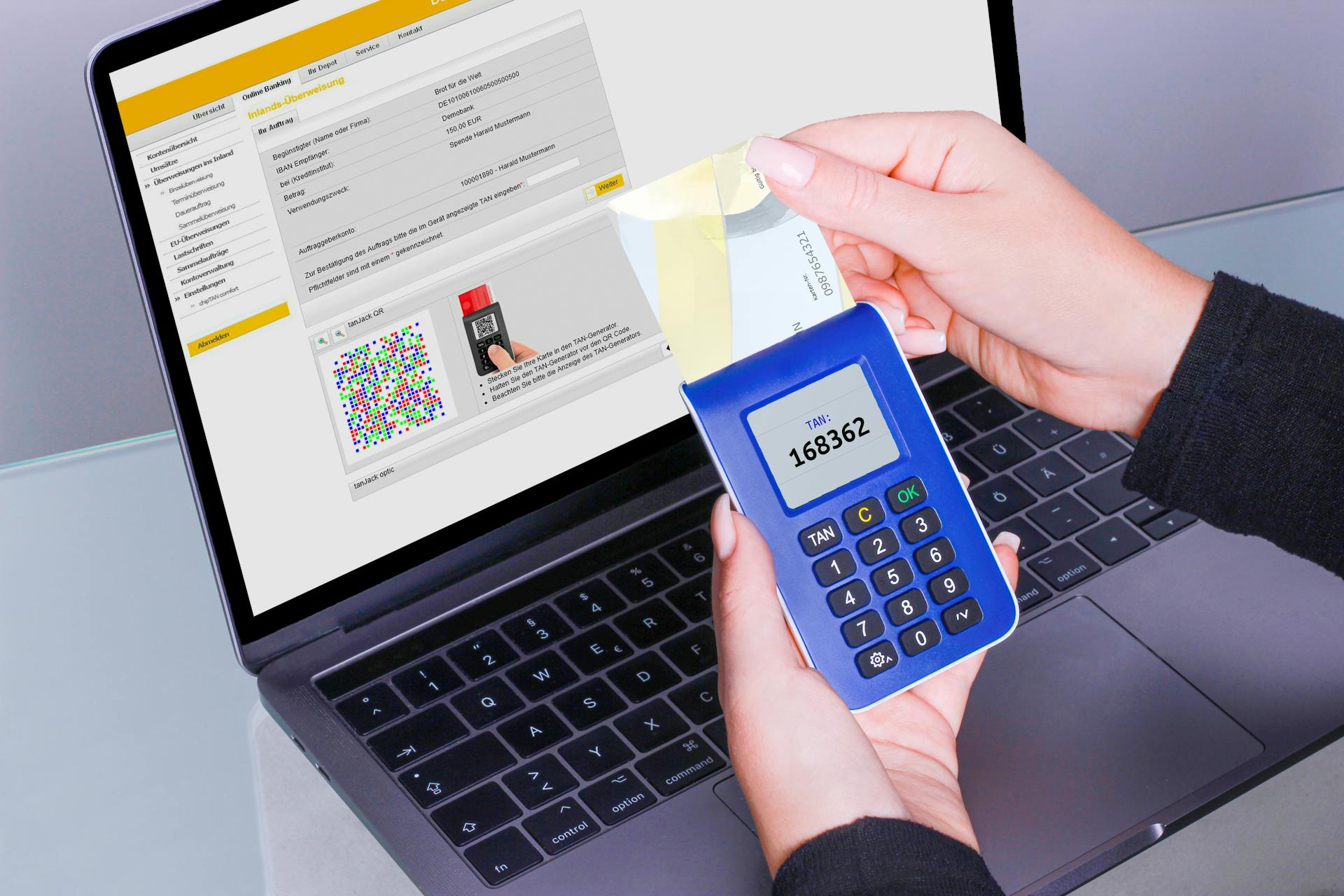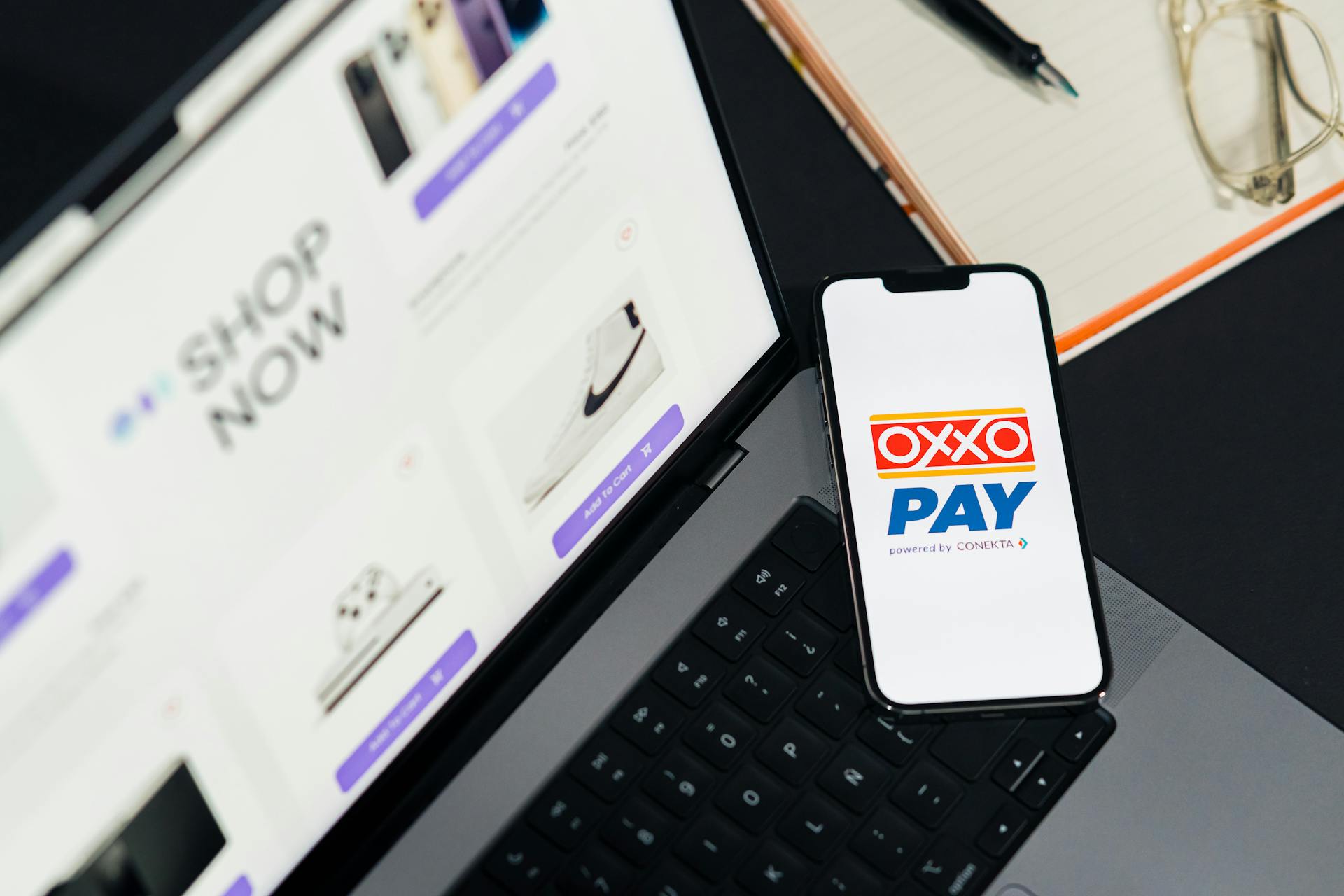
Online payments have revolutionized the way we shop, bank, and conduct financial transactions. In fact, online payments are expected to reach $14.7 trillion by 2027.
With the rise of e-commerce, online payments have become a necessity for businesses and individuals alike. In 2020, 63% of online shoppers used credit or debit cards to make purchases.
To navigate the world of online payments, it's essential to understand the different types of payment methods available. This includes credit cards, debit cards, bank transfers, and digital wallets like PayPal and Apple Pay.
These payment methods offer varying levels of security, convenience, and fees. For instance, credit card payments often come with higher fees than bank transfers.
Check this out: Shopping Cart Tricks for Credit Cards
Online Payment Methods
Online payment methods vary across the globe, with 40% of consumers outside the US preferring payment methods other than credit or debit cards. This can result in lost sales if you don't offer the preferred payment methods of your global audience.
Intriguing read: Shop Pay Payment Methods
To capitalize on a global customer base, consider offering five common types of payment methods: credit cards, digital wallets, bank debits and transfers, buy now, pay later, and cash-based payment methods. Digital wallets, such as Apple Pay and Google Pay, allow customers to pay for products or services electronically by linking a card or bank account.
You can also consider offering bank transfers, which move money directly from a customer's bank account. This can be done through services like iDEAL in the Netherlands or Giropay in Germany. Some payment methods, like buy now, pay later, offer customers immediate financing for online payments, typically repaid in fixed installments over time.
Here are some of the most popular online payment methods:
- Credit cards: Visa, Mastercard, American Express, Discover, Diners Club, JCB, UnionPay, and all major credit cards.
- Debit cards: Visa Debit, Mastercard Debit, Maestro, and more.
- Digital wallets: Apple Pay, Google Pay, PayPal, WeChat Pay, Alipay, and more.
- Buy now, pay later: Klarna, Afterpay, Affirm, and many more.
- Bank transfers: iDEAL, Sofort, Bancontact, Giropay, EPS, and many more.
Global Methods
In many countries outside the US, 40% of consumers prefer to use a payment method other than a credit or debit card. This includes bank transfers and digital wallets like Alipay and WeChat Pay.
To tap into a global customer base, you need to offer the payment methods that are most commonly used in the countries where you operate. There are five common types of payment methods.
Here are the five common types of payment methods:
- Credit and debit cards allow customers to borrow funds or deduct money directly from a checking account.
- Digital wallets like Apple Pay and Google Pay let customers pay electronically by linking a card or bank account.
- Bank debits and transfers move money directly from a customer’s bank account.
- Buy now, pay later options offer customers immediate financing for online payments, typically repaid in fixed installments over time.
- Cash-based payment methods allow customers to make online purchases without a bank account.
Some popular local payment methods include Giropay in Germany, iDEAL in the Netherlands, and OXXO and Boleto, which allow customers to make online purchases without a bank account.
You can gain instant access to popular local payment methods with one integration, allowing you to create experiences tailored to each customer.
Credit/Debit Card
Credit and debit cards are the default way to accept payments online in many industries, including the US. They're considered the de facto standard.
You can accept a wide range of credit cards, including Visa, Mastercard, American Express, Discover, Diners Club, JCB, UnionPay, and all major credit cards. Debit cards like Visa Debit, Mastercard Debit, Maestro, and more are also supported.
A different take: Online Credit Card Account
In addition to credit and debit cards, you can also accept digital wallets like Apple Pay, Google Pay, PayPal, WeChat Pay, Alipay, and more. This provides customers with a convenient and streamlined payment experience.
To accept card payments online, you'll need a payment gateway that connects your website to the processor networks. This allows customers to submit their credit card details and receive approval from the cardholder's bank.
Some popular card payment gateways include Visa Checkout, American Express, and Masterpass by Mastercard. These services make it easy for customers to checkout on your website with their preferred card type.
Here's a summary of the major credit and debit card providers:
- Visa
- Mastercard
- American Express
- Discover
- Diners Club
- JCB
- UnionPay
Note that the specific payment methods available to your business will depend on your location and the types of customers you're targeting.
Ach Debit
ACH Debit is a type of payment method that allows your business to withdraw funds directly from a customer's account when payment is due. This eliminates late payments almost entirely, improving cash flow and reducing financial admin.
The main benefit of ACH Debit is its automated nature, which reduces the amount of manual admin required. ACH Debit is best suited for businesses that want to be paid on time while keeping transaction fees and manual admin low.
ACH Debit is known as a 'pull' payment, where the business 'pulls' the payment from the customer account automatically. This is in contrast to card payments, which are known as 'push' payments.
ACH Debit tends to be cheaper than card payments, as well as requiring less accounting and payments admin. This is because bank payment methods like ACH Debit are direct account-to-account transfers, whereas cards require the involvement of several intermediaries to complete payments, each of whom charges a fee.
To use ACH Debit, you'll need to give your customers access to your direct deposit information, including your bank's routing number and bank account number. Some companies may require a voided check or authorization form from your bank, but many will initiate ACH with just your bank information.
Here are some key benefits of ACH Debit:
- Reduces late payments and improves cash flow
- Automates financial admin and reduces manual work
- Can be cheaper than card payments
- Requires less accounting and payments admin
Overall, ACH Debit is a convenient and cost-effective payment method that can help your business streamline its financial operations.
Transaction Process
Online payments involve a series of steps that facilitate the transfer of funds from a customer to a business. The transaction process starts with a payment processor that sends payment information between the merchant, the issuing bank, and the acquirer.
There are four major players involved in each online transaction: the cardholder, the merchant, the acquirer, and the issuing bank. The cardholder is the person who owns a credit card, the merchant is the business owner, the acquirer is a bank that processes credit card payments on behalf of the merchant, and the issuing bank is the bank that extends credit and issues cards to consumers.
Here's a breakdown of the online payment flow:
- Cardholder: The person who owns a credit card
- Merchant: The business owner
- Acquirer: A bank that processes credit card payments on behalf of the merchant and routes them through the card networks (such as Visa, Mastercard, Discover, or American Express)
- Issuing bank: The bank that extends credit and issues cards to consumers on behalf of the card networks
To accept online card payments, you need to work with each one of these players. This involves setting up a business bank account and establishing a relationship with an acquirer or payment processor. Acquirers and processors help route payments from your website to card networks, such as Visa, Mastercard, Discover, and American Express.
Checkout and Forms
The checkout experience is a crucial part of the online payments process, and it's essential to get it right. If your checkout form is too complicated, 87% of customers will abandon their purchase.
To improve your checkout completion rate, go through your own checkout process from the customer's point of view and look for any friction that could lead to drop off. Pay attention to how long the site takes to load, how many fields are in your form, and if your checkout process supports autofill.
Autofill can save customers' card details, allowing them to automatically add them at checkout on Chrome and Android devices. Industry-level security ensures autofill is a safe way to pay fast online.
The best checkout forms adapt to the customer's experience, offering responsive checkout forms that automatically resize to mobile devices and numerical keypads when entering card information. Consider supporting mobile payment methods like Apple Pay or Google Pay to bypass manual data entry.
Here are some key considerations for international checkout:
If you choose to expand internationally, your checkout form should cater to each market by allowing customers to pay in their local currency and supporting local payment methods.
Managing Risk and Fraud
Managing risk online is crucial for businesses that accept payments online. The majority of illegitimate payments involve fraudsters pretending to be legitimate customers by using stolen cards and card numbers.
Fraudulent transactions can result in chargebacks, which can be costly for businesses. If a business loses a dispute, it can lose the original transaction amount and have to pay a chargeback fee.
To manage risk and prevent chargebacks, businesses can use rules-based logic or machine learning. Rules-based logic operates on an "If x happens, then do y" logic, but it doesn't recognize hidden patterns and can be inflexible. Machine learning, on the other hand, can use transaction data to train algorithms that learn and adapt, making it a more effective approach to fraud management.
Worth a look: Electronic Transaction for Payment Explanation
Managing Risk
Managing risk is crucial for any business, especially when it comes to online transactions. Fraudsters often pretend to be legitimate customers by using stolen cards and card numbers.
Chargebacks can be a significant problem for businesses, as they can result in the loss of the original transaction amount and a chargeback fee. This can be a major financial burden.
Fraud management based on machine learning can use transaction data to train algorithms that learn and adapt, making it a more scalable and efficient approach than rules-based logic. Machine learning models can even train themselves, making them more effective at detecting fraud.
Rules-based fraud detection operates on a strict logic that doesn't recognize hidden patterns or adapt to shifting fraud vectors. This can leave businesses playing catch up, manually creating new rules after they detect fraud.
Fraud is any false or illegal transaction, often resulting from stolen card numbers or checking account data. Chargebacks occur when cardholders question a payment with their card issuer, placing the burden on the merchant to prove the transaction was authorized.
Chargeback fees are the costs incurred by the merchant when the acquiring bank reverses a card payment. To avoid chargebacks, businesses should offer excellent customer service, have a refund policy in place, and provide clear billing information.
Customizing your risk setup and detecting, preventing, and responding to fraud are key to managing risk effectively.
Additional reading: Amazon Transaction Pay
Verify Users During Onboarding
Verifying users during onboarding is a crucial step in managing risk and fraud. This step is complicated due to stringent laws and regulations including Know Your Customer (KYC) laws.
Collecting user information can be delicate, as you want to balance the need for data with the user experience. You want to collect as much information as possible to ensure your platform isn’t being used for nefarious purposes.
To help remove friction, consider collecting data in a phased approach. Auto-completing fields for users when possible can also make the process smoother.
For example, you could only ask for sellers’ or service providers’ tax information once they pass an IRS reporting threshold.
Take a look at this: How Many Paytm Users in India
Taking Direct Debit
Taking Direct Debit can be a great way to reduce the risk of late payments, as it eliminates the need for customers to manually initiate payments. This is because ACH Debit is a 'pull' payment method, where the business directly withdraws funds from the customer's account when payment is due.
The automated nature of ACH Debit also reduces the amount of financial admin required, making it a cost-effective option for businesses. ACH debit tends to be cheaper than card payments, as it involves direct account-to-account transfers.
Rules are in place to protect consumers, so businesses can feel confident in using this method to collect payments. However, it's worth noting that ACH debit isn't suitable for businesses that require instant online payments.
Bank payment methods like ACH Debit have cheaper transaction fees than cards because they don't require the involvement of intermediaries. This makes it a more efficient option for businesses that want to reduce their transaction fees.
For more insights, see: Wix Credit Card Processing Fees
Payment Gateways and Infrastructure
Payment gateways are a crucial part of online payments, and leveraging existing infrastructure can simplify the process.
A payment gateway is a piece of software that encrypts credit card information on a merchant's server and sends it to the acquirer. This is often the same entity as the gateway service.
Worth a look: Moneybookers Payment Gateway
By using a payment gateway, you can unify your online and offline channels, creating a seamless payments experience for customers. This means customers can start a subscription in person and continue it online, with their payment method saved to their online profile.
Here's a brief overview of the benefits of leveraging existing infrastructure:
- Saves time and resources
- Simplifies reporting
- Creates a unified customer experience
Leverage Existing Infrastructure
Setting up two separate payment providers for online and in-person purchases can be a nightmare, requiring double the work and doubling the complexity.
Retailers often have to deal with two separate integrations and accounts, making it hard to manage financial reconciliation and siloing customer data.
This can be avoided by leveraging your existing payments infrastructure, which you've already set up for online payments.
By doing so, you can save time and resources, simplify reporting, and create a more unified customer experience.
For example, customers can start a subscription in person and have it continue online, with their payment method saved to their online profile.
Stripe Terminal helps unify online and offline channels with flexible developer tools and pre-certified card readers.
If this caught your attention, see: Customer Pay Shop Charge for Repair Order
Gateway
A payment gateway is a piece of software that encrypts credit card information on a merchant's server and sends it to the acquirer.
It's often the same entity as the gateway service, which handles the secure transmission of sensitive payment data.
A payment gateway can verify the customer is who they say they are, unlike a payment processor.
This is an important distinction, as it can help prevent fraudulent transactions.
In fact, a payment gateway can't verify the customer's identity, whereas a payment processor can't verify the customer is who they say they are.
This is why it's essential to choose the right payment gateway for your business.
Here are some key differences between payment gateways and payment processors:
By choosing the right payment gateway, you can ensure a secure and seamless payment experience for your customers.
Amazon Pay is another option to consider, as it's an international gateway that opens up convenient checkout for anyone who has an existing account on the site.
It's worth noting that Amazon Pay is a newer addition to the online payments landscape, but it's still a suitable choice for your website.
Featured Images: pexels.com


